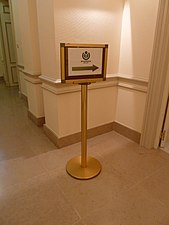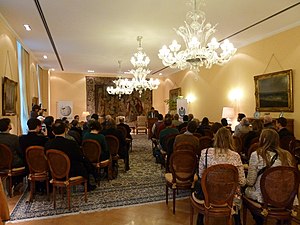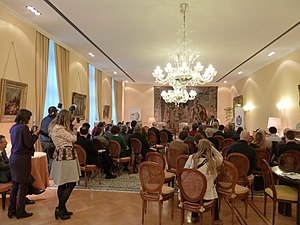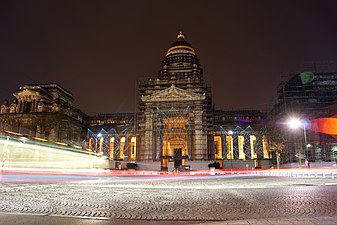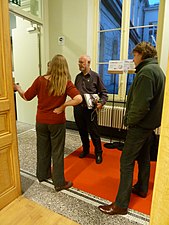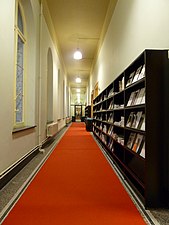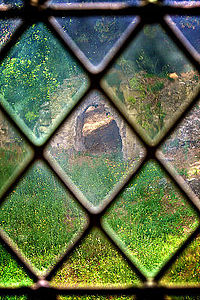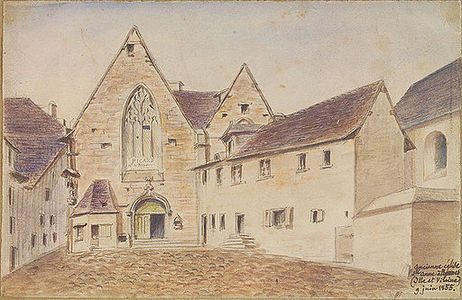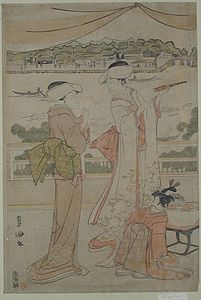GLAM/Newsletter/November 2014/Single
|
ALIA partnership goes countrywide
"Wikipedia and Libraries" series with ALIA

Throughout October and November, Wikimedia Australia (WMAU) volunteers embarked on a series of "Wikipedia and Libraries" presentations delivered across the country to members of the Australian Library and Information Association (ALIA) — the peak professional organisation for the Australian library and information services sector. The talks served as a general beginners guide to Wikipedia, as well as describing the Wikimedia movement, its relationship with the GLAM sector, and examples of how Wikipedia and the Library sector can work together.
These events had one of the widest geographic footprints of any Wikimedia Australia program, with talks attended by a combined total of approximately 280 people across seven widely dispersed Australian cities: Perth, Adelaide, Melbourne, Hobart, Canberra, Sydney and Brisbane. Wikipedians involved in the talks included Pru.mitchell, our primary liaison with ALIA, as well as presenters Gnangarra, Bilby, Chuq, Steven Zhang, Whiteghost.ink and Lankiveil. Live tweets from some of the talks can be found under the #aliawikip hashtag.
The presentations are part of a larger partnership between ALIA and WMAU, which also includes representation at the ALIA National Conference in October (see last month's report) and a series of editing workshops across the country to be run in 2015 by professional librarians who are also experienced Wikipedians. Having registered their interest in advance and attended these presentations, trainees will be able to bring an understanding of the principles, practice and range of WM projects to the workshops. We expect that will allow more time in the training sessions for skill development.
Workshops for collection holders across Europe; Founding event of Wikimedia Belgium; Wiki Loves Monuments in Belgium & Luxembourg; Plantin-Moretus Museum; Edit-a-thon at faculty library in Ghent University; Image donation UGentMemorie; Upcoming activities
Workshops for collection holders across Europe
On 17, 19 and 20 November three workshop were given in Brussels in the office of the Wallonia-Brussels Foundation for collection holders across Europe. These workshops were organized by Europeana, Culture24 and Plurio with on site support by some people from Wikimedia. These workshops explored how each of these themed digitised collections can be utilised to reach out to tourism audiences.
Each of the days focussed on one particular subject:
- Art Nouveau collections on 17 November
- Battle of Waterloo-related collections on 19 November
- First World War collections on 20 November
The workshops gave examples of re-use and mapped the needed route for organisations to open up their collections to make re-use possible. Various cultural institutions from across Europe were present to learn more about how to do it.
- Invitation
- Photos: 17 November, 19 November, 20 November
Founding event of Wikimedia Belgium
On 19 November 2014 the founding event of Wikimedia Belgium was organized in the drawing rooms of the president of the Belgian Chamber of Representatives. We were welcomed by the president, Siegfried Bracke (fr/nl), who gave a speech about the importance of Wikipedia and how he uses it. After him followed the president of our chapter, the vice-president and the in Belgium well-known Michiel Hendryckx (fr/nl). After the talks, the president of the Belgian Chamber of Representatives invitated us for a toast and to have a talk with each other.
-
Buildin of the Belgian Federal Parliament
-
Entrance
-
To the founding event
-
The public
-
with press
-
Siegfried Bracke, president of the Belgian Chamber of Representatives giving his speech
-
Siegfried Bracke during his speach
-
President of Wikimedia Belgium
-
Vice president of Wikimedia Belgium
-
Michiel Hendryckx gives his speech
-
President of WMBE receives a present
-
Prsident WMBE receives present from the Open Knowledge Foundation
Wiki Loves Monuments in Belgium & Luxembourg
For the fourth time Wiki Loves Monuments has been organized in Belgium and Luxembourg from 1 September to 30 September. During this month we organized also a Wiki Takes... Leuven to improve the coverage of the monuments of this city. In the contest 153 users participated with in total 2568 photos. In October the jury selected the 10 best photos:
-
1. The main building at the Hasard Cheratte coal mine in Liège
Author: Msemmett -
2. Law Courts of Brussels
Author: Alfredcar03 -
3. Belfry of Bruges
Author: Pedro J Pacheco -
4. Saint Nicholas Church in Ghent
Author: Teseum -
5. Castle Ooidonk in Deinze
Author: Francisco Conde Sánchez -
6. Chapelle Notre-Dame de Chèvremont
Author: Jean Maréchal -
7. Castle Horst in Sint Pieters Rode
Author: Francisco Conde Sánchez -
8. Citadelle de Dinant
Author: Mjjmartinlux -
9. Grand Place of Brussels
Author: Francisco Conde Sánchez -
10. Castle Alden Biesen in Rijkhoven
Author: Francisco Conde Sánchez
Besides the uploaders of these winning photos, a special thanks (and prize) was for five participants for their large contributions to our photo contest. On 26 November we organized a prize giving ceremony for the winners, which was hosted in the conference room of the Royal Institute for Cultural Heritage in Brussels, next to the Parc du Cinquantenaire. Afterwards our host provided something to drink and snack, and space to chat.
Organizing Wiki Loves Monuments wasn't possible without the support from our sponsors and partners. Our partners and sponsors: Royal Institute for Cultural Heritage, Agentschap Onroerend Erfgoed (VIOE) (Flanders Heritage Agency), Brussels Capital Region, Creative Commons Belgium and the Wikimedia Foundation.
- Website Wiki Loves Monuments in Belgium & Luxembourg
- Images from Belgium
- Images from Luxembourg
- Invitation to the prize giving ceremony of Wiki Loves Monuments 2014
- Overview of winners
- More photos of the awards ceremony
-
The venue before
-
A speech by the Royal Institute for Cultural Heritage
-
The jury explaining why which photo has been selected
-
The drink and talk afterwards
Plantin-Moretus Museum
On 27 November two members of the Wikimedia community and someone from Packed, expertise centre for digital heritage, had a meeting with the historic Plantin-Moretus Museum about working together with Wikimedia/Wikipedia.
Edit-a-thon at faculty library in Ghent University
On 28 November an edit-a-thon was organized at the faculty library of literature and philosophy (Faculteitsbibliotheek Letteren & Wijsbegeerte) at Ghent University. The participants worked on the extension and improvement of about 30 articles related to the history of the university.
Lunch was provided by the library and we also had a guided tour through the faculty library.
-
A helping hand by an experienced user
-
Working on articles
-
Lunch
-
Lunch
-
Tour through the library
See also:
Image donation UGentMemorie
On 29 November the team of UGentMemorie donated 125 photos to Wikimedia Commons. UGentMemorie is a non-profit project of Ghent University researchers and students, about the history of Ghent University.
Upcoming activities
- Image donation by Fashion Museum Antwerp (December 2014)
- Project at the European Commission (2015)
- Soima 2015 Conference
- Wiki Loves Art in Belgium (2015-2016)
Wiki Loves Monuments; mass upload; Musée de Bretagne
Wiki Loves Monuments

The 2014 edition of Wiki Loves Monuments in France gathered 17,842 photographs.
The awards ceremony was held at the Musée des Arts et Métiers at the end of November.
-
Stairs from the cave to Château de Gavaudun, Lot-et-Garonne
Fonds Berthelé
Jean-Frédéric and Caroline performed a mass upload of the Fonds Berthelé from the City Archives of Toulouse, partly using the GlamWiki Toolset. These 2000 photographs were taken by Raoul Berthelé and depict scenes from World War I.
Musée de Bretagne
A global collaboration between GLAMs from Rennes (central library, museum of Brittany...) and the Wikimédia France's local group, including conferences and workshops exists since September 2014. In December, a workshop about local churches is planned. For this, the museum of Brittany (musée de Bretagne) has uploaded images of local churches on Wikimedia Commons (here and there).
Facts, fun and free content
Shaping access - Germany's major GLAM conference

Winter was giving its early welcome to almost 500 attendees to Germany's major GLAM conference Shaping access in Berlin. Most attendees of this conference work in GLAM institutions. They want to learn more on the potencials of colaborating with internet-players like Wikimedia but also Europeana or simple the net community altogether. The two day program included panels on the international copyright debate, the status quo of digitization both in the film sector, for Jewish culture goods and on the challenges of multi language thesaurii. Wikimedia Deutschland as one partner among twele that held the conference, stood for the part Cultural heritage 3.0. Liam Wyatt spoke about his urge for more cooperation though the long way we have come already. Roger Jøsevold explained us the Scandinavian solution: Focus on the practical solutions to make content more accessible. And in the evening below the fascinating bones of a long dead dinosaur we had al lively work show on international projects how digitized cultural heritage can inspire new creations. Resuming: Yes, we had some progress but there is still much hesitation inside the institutions. The legal frames are still not changed, and money is always an issue but what if we start with things we can do? Initiatives like the GLAM Hackathaon Coding da Vinci are furthering a change of spirits. Let's find out more next year in Hamburg.
For more details please check the blogpost in English. Or watch our clip on vimeo.
Ada Lovelace day in Dublin
Second Edit-a-thon in Ireland

The Ada Lovelace edit-a-thon took place in the Science Gallery in Trinity College, Dublin on the 2nd November. On the day five participants (three of which were new editors) engaged in some early edits, and discussed many of the issues and challenges associated with writing women's histories. With the support of both the Science Gallery and Women in Technology and Science (WITS) an enjoyable and productive day produced a number of edits, pages created and more subject areas identified for work.
Pages created
Pages Improved
As a consequence of the creation of the pages Matilda Cullen Knowles and Maude Delap have been nominated and featured in the "Did you know?" section.
National Library Conference; Wiki Loves Monuments; Archaeological Open Data; BEIC
Florence National Library Conference

On November 28th, the first official conference about wiki projects in Florence Central National Library has been jointly organized by the Library, the national professional libraries association (AIB) and Wikimedia Italia. The conference is the fourth national event organized by Italian librarians and wikimedians, after the 2013 event in Marucelliana Library and two "Bibliohackathon" held in Florence and Trento in the same year.
The conference has been opened by Liam Wyatt speaking about international context of GLAM-wiki projects and Europeana, followed by Andrea Zanni, Wikimedia Italia's president, about Wikisource, Virginia Gentilini about 2013 Europeana Fashion Editathon, Luca Martinelli about Wikidata, Dario Crespi about Wiki Loves Monuments, presented by the biblio-wikipedian Susanna Giaccai. Librarians Anna Lucarelli, Giovanni Bergamin, Elisabetta Viti and Barbara Vanin have spoken about wiki projects inside their libraries, beginning from the use of professional BNCF Subject Headings Thesaurus in Italian articles, possible connections beetwen bibliographic data and Wikibase, the first BNCF digitization on Wikisource Manuale 150 ricette di cucina di guerra (already all proofread!), to wiki courses for library patrons working on Murano glass articles in Mestre (see the Venice Libraries Bulletin for more information).
Slides are available at the conference page (in Italian only).
Wiki Loves Monuments in Pompei

The award ceremony of 2014 edition of Wiki Loves Monuments in Italy in the archaeological site of Pompei has been the better way to thank people participating in the contest this year! Wiki Loves Monuments Italy has been a huge success, with over 21000 pictures taken by one thousands participants. The news has been covered by important media all over the country (this is Repubblica.it gallery). Have a look on all the pictures uploaded on Commons for the contest here. More on the 2014 contest (winners, special prizes and so on) is available here.
Archaeological Open Data Manifesto
Wikimedia Italia subscribed the Manifesto Open Data Archeologici (MODA) promoting open access and open data for archaeology sector. The initiative is promoted by Italian Mappa Group of University of Pisa to rise awareness about the importance of an open approach in this discipline.
A Wikipedian in Residence at BEIC: first results

The second Italian Wikipedian in Residence Federico Leva (BEIC) is working in multiple ways in his collaboration with BEIC digital library in Milan and its librarians. As a result, for instance, a new article about the Italian photographer Paolo Monti, whose archive is held in BEIC, has been created, using the biography on the institution website as the main source of information, and 1777 Meditazioni sulla economia politica by Pietro Verri, from BEIC collections, is now beeing proofread on Wikisource for the eleventh birthday of the project contest.
More details are available on halfway report (in Italian).
Video challenge; Wikidata workshop and hackathon; Wikipedia courses in libraries; WWII editathon
Netherlands Institute for Sound and Vision
Report on video challenge
Sound and Vision presented final results of the video-challenge in a blogpost: in only three weeks over 400 videos were added to articles on the Dutch Wikipedia.
Content donation
Another 185 videos have been added from the collection of the Foundation for Nature Footage (Stichting Natuurbeelden). These videos are raw shots of the Wadden Sea Islands and give a great overview of the nature and types of landscape that one can find in the northern part of the Netherlands. The videos can be found here. The full collection of the Foundation for Nature Footage can be found here.
Wikipedia courses

Library of Zeeland
A beginner course and an intermediate course Wikipedia editing were organised in cooperation with the Library of Zeeland within two weeks. Almost all of the participants of the beginner course attended the intermediate course. 14 people followed the courses in total. The participants were a mix of professionals (employees of the library) and volunteers (locals that had seen the announcement).

A wikiday was organised in cooperation with Tresoar in Leeuwarden. The morning programma included presentations about cooperating with Wikimedia and the possibilities of DBpedia and a discussion for around 35 employees of Tresoar. A beginners course was given in the afternoon were 15 people attended. The course was covered by a local TV station and the local newspaper.
Eemhuis Amersfoort
Volunteer Dick Bos organised the monthly informal Wikipedia course in the library in Amersfoort for the 6th month in a row. The concept of these trainings is that people can just walk in and ask for help. The repetition seems to be paying of: more new people attend after having seen an announcement of the training. Therefor the initiative is considered successful despite the limited number of participants so far.

Wikidata workshop for GLAMs
A lot of GLAMs are interested in the possibilities and chances that Wikidata offers them. They see opportunities to share their collection data and to track the use of or changes (enrichment) to the content and data they have donated. Wikimedia Nederland organised a workshop for GLAM professionals to get hands on experience with Wikidata. Visit the project page more information about the event.

GLAM Hackathon
Wikimedia Nederland supported the organisation of a Wikimedia Wikidata & GLAM hackathon (photos). Magic happens when you put 30 volunteers and programmers in a room for 3 days. You don't know what you'll get out of it, and trust me, you don't want to know. The unpredictable nature of an event like this would leave you unsatisfied that they didn't make what you where hoping for, but more importantly that they did make stuff that you didn't know you needed and exceeded all expectations you might have had. That's the conclusion that can be drawn of the Amsterdam Hackathon in november 2014. The event was focussed on data of Galleries, Libraries, Archives and Museums (GLAMs). And the results are mind blowing. To name a few:
- a tool that measures the time someone has looked at an image in MediaViewer,
- an interface for commons, wikidata and wikipedia that can be extended to use your own commands and let's you query these platforms,
- a website that visualises paintings added to wikidata,
- were added paintings of the Nationalmuseum in Stockholm (~4600) and of the Tate (~3200),
- hundreds paintings items lacking information (image, collection, creator....) were enriched
- translation was added to the ts reporting tool, so this tool can be translated to any language.
Europeana Taskforce meeting / GLAMwiki Toolset 2
The day after the GLAM hackathon several attendees visited The National Institute for Sound and Vision to continue work on preparing the grant application for the next version of the GLAMwiki Toolset.

Edit-a-thon WWII with NIOD
A WWII themed edit-a-thon was organised in cooperation with NIOD Institute for War, Holocaust and Genocide Studies. Participants created 3 new articles and improved 3 existing articles. They also got an exclusive tour through the NIOD building.
Preparations GLAM WIKI 2015
Wikimedia Nederland has started the preparations for the GLAM WIKI 2015 conference that will take place on April 10 to 12, 2015 in The Netherlands. The call for participants for the Program Committee, that will design the program of the conference, has been send out to several mailing lists and has been published on numerous Wikimedia related Facebook pages and groups.

GLAMout Global
GLAMout Global, the regular Google hangout on GLAM projects around the globe, took place on the 4th of November. You can watch the hangout and download the presentations.
Wikipedian in Residence meeting
The Dutch Wikipedians in Residence had a meeting on the 3rd of November. The notes of this meeting are public (Dutch).
Edit-a-thon far north at the Museum of Nordland (Nordlandsmuseet)
Nordlandsmuseet
-
Nordlandsmuseet
-
Edit-a-thon at Nordlandsmuseet
-
Sami drum
-
Anna Karoline, the last surviving jekt (freight vessel) of the Nordland type
Last month Wikimedia Norge visited Bodø and the museum Nordlandsmuseet. The museum is a central part of a larger consortium of 9 museum units in nine municipalities in Nordland County. The museums collection includes one exhibit about the old traditional North-Norwegian fisheries and the international stockfish trade with the Hanseatic League and material covering the local Sami people (Lapps). They also have an exhibition that shows a silver treasure from the Viking age. This treasure was found in Bodø in 1919 and is one of the biggest that has been found in Northern Norway. Nordlandsmuseet is working on a mass upload of images from their collection of local photographers documenting maritime culture and fisher-farmer communities in the Salten province to Wikimedia Commons.
Together with the Nordlandsmuseet and the University of Nordland Wikimedia Norge held a seminar for institutions in the Bodø-region about how the Wikimedia-projetcs can be a platform to publish and share collections. The Arts Counsil Norway also took part. After the seminar there was an edit-a-thon at the museum with 15 participants. Several Wikipedians have written and improved excellent articles about some of the objects from Nordlandsmuseets collection, like on article about the Sami drum and an article about Anna Karoline, a freight vessel.
Picasso, first Galipedia edit-a-thon, course in Biblioteca Reina Sofía and free portraits
First edit-a-thon in Picasso Foundation of Málaga
The Fundación Picasso, with the collaboration of Wikimedia Spain, organized last month an edit-a-thon in its museum Casa Natal in Málaga, the birthplace of the famous Spanish artist. Picasso was born in October, and every October, Picasso Foundation organizes different cultural activities to commemorate this, know as "Octubre Picassiano". This year there was an edit-a-thon about Picasso and its relationship with Málaga. On Monday, November 3rd, there was a talk to introduce Wikipedia and other Wikimedia projects, and finally, November 8th, the edit-a-thon was carried out. More than 25 kb were added on Wikipedia and different articles about Picasso, his work and life were edited in Spanish and English. Wikidata and Wikimedia Commons were also improved. Fundación Picasso provided bibliography about the artist from its library and participants could improve their editing abilities thanks to a Wikipedia volunteer who run the event.
First edit-a-thon about Galician Science Day at Biblioteca Intercentros in Lugo
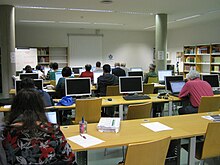
On Saturday, November 8th, the first edit-a-thon for Galipedia was celebrated. This was organized by Biblioteca Intercentros do Campus de Lugo, Galipedia community, Proxéctate en Galego and Wikimedia España. This event was organized because the Galician Science Day, and took place at Biblioteca Intercentros of Santiago University in Lugo. Near 20 people attended the event and edited on Galipedia. The organization provided a list of science articles to be improved and there were some talks, and a meet-up at the end.
See also Wikipedia:Primeiro editatón do Día da Ciencia en Galego
First Wikipedia course at University Library Reina Sofía in Valladolid

The University Library Reina Sofía of the Valladolid University and Wikimedia Spain organized the first Wikipedia course at the library Reina Sofía of Valladolid University. The course, with four sessions, let attendants improve their knowledge about Wikipedia with the guide of different wikipedians. This course provided university credits to the participants.
FECYT freely shared more than 100 portraits on Wikimedia Commons
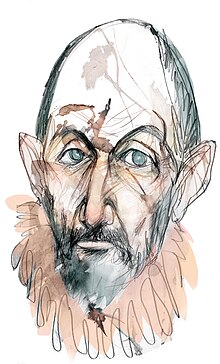
Fundación Española para la Ciencia y la Tecnología (FECYT) and Museo Nacional de Ciencia y Tecnología (MUNCYT), with the support of Wikimedia Spain, freely shared more than 100 portraits by Eulogia Merle of Spanish scientists on Wikimedia Commons. FECYT and Wikimedia Spain, with other four science museums of different cities, will organize six simultaneous edit-a-thons about Spanish scientists and inventors on December, 13th and 14th.
Wiki Loves GLAMs, Cape Town
Iziko Museums
As part of the WikiAfrica Project, we worked with the Museums below in gathering contents from them. Over 1,000 pictures related to these museums were uploaded onto Wikimedia Commons. Many thanks to the Iziko Museums for their collaboration.
For a complete category of all the images form these museums, see the Iziko Museums category on Wikimedia Commons
- Rust En Vreugd
- William Fehr @ Castle of Good hope
- Koopmans de Wet
- Slave Lodge
- Bo-kaap Museum
- Bertram House
- Iziko South African National Gallery
- Iziko South African Museum
Other Museums
Articles Started on Wikipedia
Use, reuse and contributions back and forth
Swedish empire edit-a-thon

On november 5th an edit-a-thon on the topic Swedish Empire took place at the Vasa museum in Stockholm. The edit-a-thon was a collaboration between the Vasa museum, The Royal Armoury, Skokloster Castle and the Hallwyl museum, in project GLAM. During the day several articles about the Swedish Empire were written, updated and extended by the participants, and no less than six lectures on different topics related to the Swedish Empire – such as the Swedish Empire from a gender perspective, were given. We were also given a tour of the exhibition meanwhile, where the touch table was demonstrated. With more than thirty participants, and at least as many new or extended articles, the edit-a-thon was definitely a success.
A new batch upload
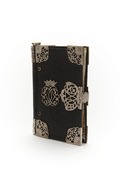
About a year ago, we at the Swedish museums The Royal Armoury, Skokloster Castle and the Hallwyl museum took an important step towards increased openness when we made 20 000 high-resolution images available on Wikimedia Commons. Since then we have photographed 6000 new objects, amongst others the collection of rifles at Skokloster castle, and now they are uploaded to Commons! One of the many benefits of the contribution to Wikimedia Commons is the increased reach of our images, nationally as well as internationally. The possibility of creating links between images, people and historic events enriches information about the museums’ collections. Since the first upload our images have been viewed more than 2.7 million times, and we are so happy that we are able to share the images of the treasures that the museums hold, and to make them available for everyone to use. Thanks to the new report page created by Fæ we can also se the use of images, popular categories and users who help improve the collection.
Metadata for Europeana
Last month we reported on the work done on exporting metadata about collections on Commons to Europeana. Now the first dataset is live showing the images from our Då&Nu competition and illustrating how the images are connected to other Europeana objects. This is a small dataset, only 59 images. But during December the 14,000 Wiki Loves Monuments in Sweden images will also go live. If you are interested in putting together your own export the code is available on GitHub and André at Wikimedia Sverige will be happy to help if you have any questions.
Donation of source code
After reuseing images and articles from Commons and Wikipedia in the Samtidigt/Meanwhile exhibition, The Vasa museum also made material available as they released the source code for the touch table connected to Wikipedia. While having the intention from the start the museum had to accepet a new policy as this was the first time they released code under a free license. The code is available at the GitHub account created by Statens maritima museer. So far the program is adapted to the Samsung SUR40 touch table running Microsoft Windows, but as it is now under a MIT license anyone can modify the code to use it with other hardware and with other categories then the ones between 1600 and 1650 that The Vasa museum populated tha table with. A new film showing how the table works is available at Youtube and was also shown at the Zugang gestalten conference in Berlin 13-14 November.
Hackathon

The 2014 Amsterdam Hackathon took place in November and was focused on GLAM activities and Wikidata. The Swedish effort focused on two projects aiming to bring GLAM data to Wikidata.
The first was to create items for the remaining paintings in the collections of the Nationalmuesum in Sweden. This was done using the data made available through Europeana and was part of the Sum of all paintings project. The end result is approximately 4,500 imported paintings. There is still more work needed to connect paintings with creators, images already on Commons. For the sub-collection from the National Portrait Gallery it would also be very interested to connect each painting with the person(s) being depicted.
The second project aimed to add and/or source statements about architects on Wikidata by making use of the dataset provided by the Swedish Centre for Architecture and Design (ArkDes). What makes this interesting is in part that ArkDes has already connected many of their architects to Wikidata items, and in part that the process aims to add sourcing statements even if the same statement is already present and already otherwise sourced. Since ArkDes is an authoritative source for this type of information, it signals that the given statement is more reliable.
Free Society Conference and Nordic Summit
Free Society Conference and Nordic Summit (FSCONS) is a conference focusing on everything open. Wikimedia Sverige had an own track and a booth. We gave talks and workshops on the Wikimedia API, how to collaborate with Wikimedia and translatewiki.net.
Working with the web in Varberg
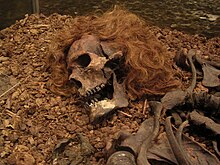
At a conference in Varberg on how to work with cultural heritage on the web organized by the National Heritage Board Axel Pettersson and Anna Frid (former employee at Hallands kulturhistoriska museum) gave a presentation about Bockstensmannen, and how a GLAM can work with the community when an article is hijacked by amature researchers with alternative theories. The Bocksten man is the remains of a man murdered in 1350-1370 and left with an oak pole through his heart. As he was lying in a bog the skeleton, hair and clothes were well preserved and are now on display at the museum. After a complete re-write by Anna Frid, with help from the community, the article was neutral and included all sides of the story with everything properly sourced. After she moved to a new job and lost touch with the article, alternative theories started to move in and take over again. A shared watchlist for the GLAM might help them keep a collective eye on both the Bocksten man and other articles they are intersted in.
#Socmus
IDEK is an organization doing things around cultural heritage and digital communication, such as running workshops, visiting museums and getting twitter discussions going using the hashtag #Socmus. Friday November 14 the #Socmus was dedicated to the topic Wikipedia and the relationship between GLAMs and the Open culture movement. During the two hour long discussion a lot or users talked about the benefits of using free licenses on material, how to get staff to contribute to articles on Wikipedia, strategies for getting released images both up to Commons and also to be used in articles and a lot more. This was the second Wikipedia #socmus, and the tweets are collected in a storify timeline. The previous one (from September 2013) can be found here.
Medals, maps and multilingual marvels
Royal Society of Chemistry

Andy Mabbett's residency at the Royal Society of Chemistry is ongoing. Highlights in November included the making of images of RSC award medals and the creation of Wikidata entries for each of the RSC's medals and awards. The tagging of the recipients' Wikidata items is ongoing. The collaboration with Catalan Wikipedians and chemists based in Catalonia, to translate key chemistry articles from English (see last month), continued. Andy also started a blog aimed at non-Wikipedians. See the project diary for other news.
British Library
- mechanical curator
The British Library released a million images scanned from old books. This collection was first loaded onto Flickr so that crowdsourcing could take place.
In particular Wikimedians and Open Street Map worked with the British Library on a project to find maps and floor plans among the million with the ambition to find 10,000 amongst the million files.
Approximately 10% of the million images were checked in an event on the 31st October and another 75% in the month of November. By the 9th December almost 95% of the million images had been checked and nearly 22,000 images identified. Subsequent steps will include geotagging and uploading to Wikimedia Commons
Three National Libraries cooperate on open content

A meeting was organised between three national libraries: the National Library of Scotland, the British Library and the National Library of Wales on 6 November 2014 to discuss cooperating on open information projects.
Scanners
The Natural History Museum has donated two high tech scanners to Wikimedia UK for us to lend out to museums, archives and others who can make good use of them.
- One Welsh local authority requested more info for use in county archives. Discussions are ongoing.
3 venue editathon WW1 & Dissent
On the 22 November, a three venue editathon was held on WWI and Dissent, starting in Birmingham and Senate House Library, London and moving on to Kansas City.
Aside from new and improved articles using access to material at the Libraries, we were also able to show someone from a relevant magazine how to upload images:
-
Women's Peace Crusade poster
Yorkshire
- It's GLAM up North! By PatHadley
- Highlights from YMT's online collections
-
A carved, bas relief eagle from Romano-British Eboracum.
-
Portrait of Monsignor Giovanni Battista Agucchi by Domenichino
-
The Middleham Jewel. A star artefact in the Yorkshire Museum
-
The Wrestlers by William Etty
-
An early, wooden-cased telescope by Abraham Sharp
-
A replica flint spear by notorious forger by Edward Simpson - 'Flint Jack'
One hundred and fifty accredited museums! Ranging from tiny, volunteer-run collections in village halls, to national scientific and and industrial museums; Yorkshire has an over abundance of GLAMwiki potential. Now, nearly six months into a regional GLAMwiki project, I (PatHadley) am beginning to uncover some of the treasures in the county's collections and help museums through the various challenges to digital openness and working with Wikimedia.
Though the initial results may look small, they are hopefully signs of much bigger things to come. Firstly, there has been a great response from one of Yorkshire's smallest museums: Shandy Hall. This former vicarage in the village of Coxwold was the home of the innovative writer Laurence Sterne and has begun releasing images of the site and high-quality scans of artwork related to Sterne's life (in this Commons Category). This has already led to several images making their way onto English Wikipedia on Sterne's biography and the articles on his key books: The Life and Opinions of Tristram Shandy, Gentleman and A Sentimental Journey Through France and Italy. There are plans for many more images to be released and the curators have set up a Wikipedia training session with English Literature students from Northumbria University to help improve content related to Sterne. There are also factual resources on the Sterneana pages of the Laurence Sterne Trust (who run Shandy Hall) that can help Wikipedians improve this related content.
- First uploads from Shandy Hall
-
Sterne and Grisette by Abraham Solomon
-
Old Kitchen fire at Shandy Hall
-
Tristram Shandy First edition spines
-
West entrance of Shandy Hall in snow
A new directory for GLAMwiki?
One pilot scheme in the project has grown out of a talk at Wikimania. This is an attempt to create a uniform directory of pages for GLAMs involved in GLAMwiki in order to provide an easy-to-navigate place for GLAM professionals and Wikipedians who may find the sprawling plethora of GLAM project pages confusing. This proposal got a very positive reception at Wikimania and staff at the three best presented directory pages (National Media Museum, Shandy Hall, York Museums Trust have been thrilled at the clear representation of their work. It is hoped that a directory of global GLAMwiki projects can be built in this way and that the discussion pages on each directory page can become a useful space for Wikimedians to engage with GLAM staff.
Fifty thousand open images
The most dramatic victory so far has been that the host institution, York Museums Trust, has embraced open licensing as a whole. This means that the entire collection catalogue of 160,000 objects is now online. 50,000 of these objects are accompanied by free-to-use images on en:CC-BY-SA or en:Public Domain licenses.
Two of the galleries in this article show a handful of the best images that have already been transferred to Commons. It is hoped that this is the first of many transfers and there are plans to use the GLAMwiki Toolset to perform mass uploads.
So what's next? More of the same! Big museums such as the National Media Museum are in discussions about licensing and their image archives. At the other the end of the spectrum, I am working with York Museums Trust's digital team to provide small sites such as the Stewart Museum with the capacity to photograph some of their key objects and improve their digital openness. Wikimedians are encouraged to get in touch (on Wiki or by email) if they have ideas for the project or ways in which Yorkshire's museums can strengthen particular gaps on Wikimedia sites.
- More highlights from YMT's online collections
-
Biblical warrior Benaiah in battle by William Etty.
-
The type specimen of Rhomaleosaurus zetlandicus, on display at the Yorkshire Museum
-
Preserved hair from a Roman coffin found in the 1870s during excavations on the site of York Railway Station.
-
A Utagawa Toyokuni print of two ladies examining an early telescope
-
A medieval stained glass roundel of a King
-
Saint Francis receiving the stigmata by Cima da Conegliano
The Yorkshire Network Project is coordinated by PatHadley as the Regional Wikimedia Ambassador. It is hosted by York Museums Trust and funded by Wikimedia UK as part of the global GLAMwiki project
Science Museum Late
- A night in the Science Museum by Roberta Wedge

On the last Wednesday of every month, the Science Museum throws open its doors for an adults-only evening called a Late. WMUK collaborated with them for the event themed around the Information Age on 26 November, when close to 4000 mostly 22 to 35 year olds got to engage with multiple Wiki projects. We had dozens of WMUK volunteers helping these visitors record their voice for Wikiproject Spoken Wikipedia and upload their photos of the new gallery to Wikimedia Commons. These Lates are known for drinking and thinking: at the more serious end of the spectrum, visitors listened to one of the founders of Wikiproject Medicine, and at the more lighthearted end, they crowdsourced found poetry. In between, volunteers circulated, asking them to complete our brief questionnaire. "What would life be like without Wikipedia?"
Blog posts
- The Public Catalogue Foundation wrote a blog post, "Wikipedia entry created as a result of discussion".
- Andrew Gray wrote: Wikidata identifiers and the ODNB – where next?
Other news
Welsh language site Cymdeithas Edward Llwyd is trialling the use of images from Commons to illustrate its 'Species Dictionary'. This can be viewed here. Type in 'Buwch' and view the ladybirds.
Fae has created a tool which logs usage of images and other stats for GLAM bulk uploads and other sets. You may view some examples.
ORCID identifiers
The facility to display an ORCID identifier as part of an authority control template in an article and/ or on a user page, is now available in over 50 Wikipedias and sister projects, (and as P496 in Wikidata).
An ORCID identifier is like an ISBN, or a DOI, but for an author, editor or other contributor to literature, to research - or to Wikipedia.
For example, say you're reading a paper by William Smith. How do you know whether that’s the William Smith whose reputation you trust, or a namesake you don’t, or one you’ve never heard of? How can we associate and catalogue works by “William Smith”, “W. B. Smith”, “Bill Smith” and so on, when they’re all by the same person – indeed, how do we tell whether or not they are by the same person? What happens if he becomes William Smith-Jones upon marriage, or takes a completely different name on changing of religion? ORCID IDs solve that problem.
GLAM Wikipedians and their editing-trainees may register for an ORCID ID, to disambiguate themselves from others with similar names, and to associate their contributions with any academic or public outreach authorship. Registration is free, at http://orcid.org/
ORCIDs can then be displayed on user pages, and may also be added to articles about people including of course GLAM staff and academics. See WP:ORCID, or contact Andy Mabbett, Wikipedian in Residence at ORCID, for details.
ORCID is an open, non-profit organisation.
Open proposal: Wikidata for Research; Open Access signalling
Open research proposal

A H2020 research proposal about integrating Wikidata more closely with data- and metadata-oriented research workflows is currently being drafted in the open on Wikidata, and a blog post is available for background. While the exact composition of the consortium and the descriptions of the workpackages are still being worked on, two GLAM institutions are already involved (the Museum für Naturkunde Berlin and The European Library), and facilitating GLAM-related research is one of the aims of the project. This entails work on identifiers like ORCIDs (see also the Special story) as well as on enriching Wikidata with metadata and data from external sources, as well as reuse of and training about Wikidata in research contexts. The submission deadline is January 14, and feedback is much welcome until then.
Open Access signalling
The Open Access signalling pilot project ended in November, and the final report is being drafted. In brief, it established an infrastructure that allows to upload openly licensed scholarly articles onto Wikisource, so that they can be more easily referenced in Wikipedia (e.g. via deeplinking), and their open licensing signalled to the reader. Images associated with these articles go to Wikimedia Commons, from where they are embedded into the Wikisource version of the article, and can be embedded in any other Wikimedia page. The project also has provisions for integrating with the Open Access Button and with Wikidata. In preparation of further streamlining of reference management across Wikimedia platforms, an audit of the available tools has been performed (see also the Tool testing report).
In brief
- Open theses: A page has been started to collect information about Open theses, i.e. PhD theses drafted and/or published in the open.
- Open thesaurus: The Public Library of Science have open-sourced the thesaurus they use to categorize the articles they publish, and recently put it under CC0.
- JATS-Con submissions: JATS-Con is the conference about JATS, the XML format that publishers use to deposit articles in PubMed Central. The JATS4R workgroup aims at improving the reusability of JATS in contexts like the Open Access Media Importer or the Open Access Signalling project, and the Force11 Data Citation Implementation Group on extending JATS such that it can be used for data citation. Both groups have submitted abstracts to the next JATS-Con, which will take place on April 21-22, 2015.
- Open Access Reader: Development work has started for the Open Access Reader (demo).
Open Access Media Importer
The following represents a selection of the ca. 300 files that have been uploaded by the Open Access Media Importer this month, bringing the total to over 18,000. If you can think of wiki pages where these files could be useful, please put them in there or let us know.
Tools for references, images, video, file usage; Popular Pages
A few weeks ago, a discussion referred to "tool testing reports, the last one of which is unfortunately more than a year old". I take this as an occasion to give it another go.
Tools for managing references
There are many different ways in which references are being handled across Wikimedia platforms, and Matt Senate has systematically surveyed the tools available for that. This is an important step in preparation of bringing reference metadata onto Wikidata more systematically, and making that information available to other Wikimedia platforms.
WikiProject-based view stats
The tool Popular Pages allows editors to create lists of popular articles within the scope of a given WikiProject, ordered by view count. For an example, see the WikiProject Computational Biology instance that has recently been set up.
Media file request counts
A request for comments about the specifications of the new media file request dumps is ongoing. They will provide the basis for file-level usage stats, so feedback from the GLAM community that has provided Wikimedia Commons with hundreds of thousands of images and other media files so far would be very welcome.
Images on Wikidata
Magnus Manske wrote a blog post about how many images are being used on some of the larger Wikimedia projects. His analysis suggests that Wikipedia articles (across languages) could benefit from more systematic inclusion of relevant images already known to Wikidata, and he has a tool that works in the opposite direction - adding images to Wikidata based on the corresponding Wikipedia articles.
Videos in Wikipedia articles
The tool articlemedia (seen at de:Benutzer:Atlasowa/Video) lists Wikipedia articles (currently, English and German only) that have videos embedded. It thus complements category listings like en:Category:Articles containing video clips. I tested the tool for both languages, with format "Wikitext" and with "filenames" checked. The results are available as (large) subpages of this page (English/ German).
December's GLAM events
| <<< previous month | December 2014 | next month >>> | ||||
|---|---|---|---|---|---|---|
| Monday | Tuesday | Wednesday | Thursday | Friday | Saturday | Sunday |
| 1 |
2 |
3 |
4 |
5 |
6 |
7 |
| 8 |
9 | 10 |
11 |
12 |
13 | 14 |
| 15 |
16 |
17 |
18 |
19 |
20 |
21 |
| 22 |
23 |
24 |
25 |
26 |
27 |
28 |
| 29 |
30 |
31 |
1 |
2 |
3 |
4 |











